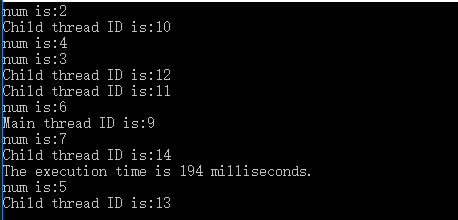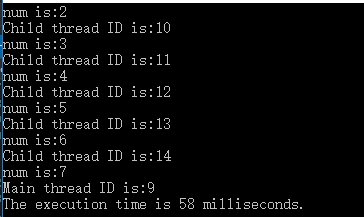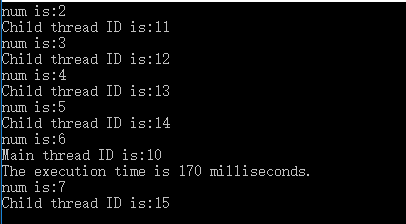上一篇博客学习了如何简单的使用多线程。其实普通的多线程确实很简单,但是一个安全的高效的多线程却不那么简单。所以很多时候不正确的使用多线程反倒会影响程序的性能。
下面先看一个例子 :
class Program{static int num = 1;static void Main(string[] args){Stopwatch stopWatch = new Stopwatch();//开始计时stopWatch.Start();ThreadStart threadStart = new ThreadStart(Run);for (int i = 0; i < 5; i++){Thread thread = new Thread(threadStart);thread.Start();}num++;Console.WriteLine("num is:" + num);Console.WriteLine("Main thread ID is:" + Thread.CurrentThread.ManagedThreadId.ToString());//停止计时stopWatch.Stop();//输出执行的时间,毫秒数Console.WriteLine("The execution time is " + stopWatch.ElapsedMilliseconds + " milliseconds.");Console.ReadKey();}public static void Run(){num++;Console.WriteLine("num is:" + num);Console.WriteLine("Child thread ID is:" + Thread.CurrentThread.ManagedThreadId.ToString());}}
执行结果:
从上面可以看出变量 num
的值不是连续递增的,输出也是没有顺序的,而且每次输出的值都是不一样的,这是因为异步线程同时访问一个成员时造成的,所以这样的多线程对于我们来说是不可控的。以上这个例子就是非线程安全的,那么要做到线程安全就需要用到线程同步。线程同步有很多种方法,比如之前用到过的
Join() 方法,它也可以实现线程的同步。下面我们来试试:
class Program{static int num = 1;static void Main(string[] args){Stopwatch stopWatch = new Stopwatch();//开始计时stopWatch.Start();ThreadStart threadStart = new ThreadStart(Run);for (int i = 0; i < 5; i++){Thread thread = new Thread(threadStart);thread.Start();thread.Join();}num++;Console.WriteLine("num is:" + num);Console.WriteLine("Main thread ID is:" + Thread.CurrentThread.ManagedThreadId.ToString());//停止计时stopWatch.Stop();//输出执行的时间,毫秒数Console.WriteLine("The execution time is " + stopWatch.ElapsedMilliseconds + " milliseconds.");Console.ReadKey();}public static void Run(){num++;Console.WriteLine("num is:" + num);Console.WriteLine("Child thread ID is:" + Thread.CurrentThread.ManagedThreadId.ToString());}}
执行结果:
这样就实现了简单的同步,相比起上面的代码也就只是添加了一行代码(thread.Join();),之前也提到了 Join()
这个方法用于阻止当前线程,直到前面的线程执行完成。可是这样虽然是实现了同步,但是却也阻塞了主线程的继续执行,这样和单线程貌似没什么区别了。既然这样我们再去学习一下其他的方法。
实现线程同步还有一种锁的机制,下面是一种最简单的锁机制,即使用 lock。如下:
class Program{private object locker = new object();int num = 1;static void Main(string[] args){Program program = new Program();Stopwatch stopWatch = new Stopwatch();//开始计时stopWatch.Start();ThreadStart threadStart = new ThreadStart(program.Run);for (int i = 0; i < 5; i++){Thread thread = new Thread(threadStart);thread.Start();}program.num++;Console.WriteLine("num is:" + program.num);Console.WriteLine("Main thread ID is:" + Thread.CurrentThread.ManagedThreadId.ToString());//停止计时stopWatch.Stop();//输出执行的时间,毫秒数Console.WriteLine("The execution time is " + stopWatch.ElapsedMilliseconds + " milliseconds.");Console.ReadKey();}public void Run(){lock (locker){num++;Console.WriteLine("num is:" + num);Console.WriteLine("Child thread ID is:" + Thread.CurrentThread.ManagedThreadId.ToString());}}}
执行结果:
lock
是一种比较好用的简单的线程同步方式,它是通过为给定对象获取互斥锁来实现同步的。可以看到这种方式的确没有阻塞主线程,而且成员变量的值也是连续递增的,说明是线程安全的。lock
锁机制表示在同一时刻只有一个线程可以锁定同步对象(在这里是locker),任何竞争的的其它线程都将被阻止,直到这个锁被释放。
lock 的参数必须是基于引用类型的对象,不要是基本类型,比如
bool、int,这样根本不能同步,原因是lock的参数要求是对象,如果传入
int,势必要发生装箱操作,这样每次lock的都将是一个新的不同的对象。最好避免使用public类型或不受程序控制的对象实例,因为这样很可能导致死锁。永远也不要
lock 一个字符串。
暂时先到这里,后面学了其他方法在继续更新。

